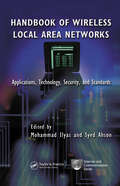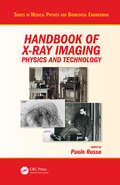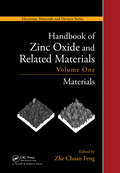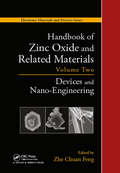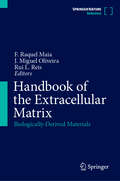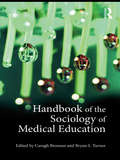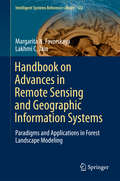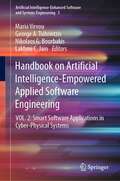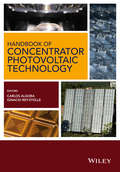- Table View
- List View
Handbook of Wind Resource Assessment
by Simon WatsonHANDBOOK OF WIND RESOURCE ASSESSMENT Useful reference text underpinning the theory behind wind resource assessment along with its practical application Handbook of Wind Resource Assessment provides a comprehensive description of the background theory, methods, models, applications, and analysis of the discipline of wind resource assessment, covering topics such as climate variability, measurement, wind distributions, numerical modeling, statistical modeling, reanalysis datasets, applications in different environments (onshore and offshore), wind atlases, and future climate. The text provides an up-to-date assessment of the tools available for wind resource assessment and their application in different environments. It also summarizes our present understanding of the wind climate and its variability, with a particular focus on its relevance to wind resource assessment. Written by a highly qualified professional in the fields of wind resource assessment, wind turbine condition monitoring, and wind turbine wake modeling, sample topics included in Handbook of Wind Resource Assessment are as follows: Climate variability, covering temporal scales of variation, power spectrum, short term variation and turbulence, the spectral gap, and long-term variation Measurement, covering history of wind speed measurement, types of measurement, terrestrial measurements, anemometers, wind vanes, lidars, sodars and remote sensing Distributions, covering synoptic scale wind distributions, turbulent scale distributions, contrast between mean and extreme values, and extreme value statistics Physical modeling, covering spatial scales of variability, the governing equations, models of varying complexity, mass consistent models, linearized models and semi-empirical models Statistical modeling, covering the use of measure-correlate-predict (MCP), wind indices and spatial interpolation Handbook of Wind Resource Assessment serves as a comprehensive text that brings together the different aspects of wind resource assessment in one place. It is an essential resource for anyone who wishes to understand the underlying science, models, or applications of wind resources, including postgraduates, academics, and wind resource professionals.
Handbook of Wireless Local Area Networks: Applications, Technology, Security, and Standards (Internet and Communications)
by Mohammad Ilyas Syed AhsonConsisting of 25 articles contributed by expert authors from around the world, this handbook begins with a detailed introduction that provides an overview of LAN technologies, performance, security, and security protocols. It then delves further into WLAN technology, covering space-time processing, WLAN and cellular convergence, and a peer-to-peer approach to roaming, along with other topics. The Handbook continues by exploring WLAN applications, followed by an extensive discussion of security that includes the steps that can be taken to minimize WLAN security risks. This text concludes with an analysis of standards, describing 3G UMTS - IEEE 802.11b internetworking and security.
Handbook of Wireless Sensor Networks: Issues and Challenges in Current Scenario's (Advances in Intelligent Systems and Computing #1132)
by Wei-Chiang Hong Pradeep Kumar Singh Marcin Paprzycki Narottam Chand Kaushal Bharat K. BhargavaThis book explores various challenging problems and applications areas of wireless sensor networks (WSNs), and identifies the current issues and future research challenges. Discussing the latest developments and advances, it covers all aspects of in WSNs, from architecture to protocols design, and from algorithm development to synchronization issues. As such the book is an essential reference resource for undergraduate and postgraduate students as well as scholars and academics working in the field.
Handbook of Wood Chemistry and Wood Composites
by Roger M. RowellWood has played a major role throughout human history. Strong and versatile, the earliest humans used wood to make shelters, cook food, construct tools, build boats, and make weapons. Recently, scientists, politicians, and economists have renewed their interest in wood because of its unique properties, aesthetics, availability, abundance, and perha
Handbook of X-ray Imaging: Physics and Technology (Series in Medical Physics and Biomedical Engineering)
by Paolo RussoContaining chapter contributions from over 130 experts, this unique publication is the first handbook dedicated to the physics and technology of X-ray imaging, offering extensive coverage of the field. This highly comprehensive work is edited by one of the world’s leading experts in X-ray imaging physics and technology and has been created with guidance from a Scientific Board containing respected and renowned scientists from around the world. The book's scope includes 2D and 3D X-ray imaging techniques from soft-X-ray to megavoltage energies, including computed tomography, fluoroscopy, dental imaging and small animal imaging, with several chapters dedicated to breast imaging techniques. 2D and 3D industrial imaging is incorporated, including imaging of artworks. Specific attention is dedicated to techniques of phase contrast X-ray imaging. The approach undertaken is one that illustrates the theory as well as the techniques and the devices routinely used in the various fields. Computational aspects are fully covered, including 3D reconstruction algorithms, hard/software phantoms, and computer-aided diagnosis. Theories of image quality are fully illustrated. Historical, radioprotection, radiation dosimetry, quality assurance and educational aspects are also covered. This handbook will be suitable for a very broad audience, including graduate students in medical physics and biomedical engineering; medical physics residents; radiographers; physicists and engineers in the field of imaging and non-destructive industrial testing using X-rays; and scientists interested in understanding and using X-ray imaging techniques. The handbook's editor, Dr. Paolo Russo, has over 30 years’ experience in the academic teaching of medical physics and X-ray imaging research. He has authored several book chapters in the field of X-ray imaging, is Editor-in-Chief of an international scientific journal in medical physics, and has responsibilities in the publication committees of international scientific organizations in medical physics. Features: Comprehensive coverage of the use of X-rays both in medical radiology and industrial testing The first handbook published to be dedicated to the physics and technology of X-rays Handbook edited by world authority, with contributions from experts in each field
Handbook of Zeolite Science and Technology
by Scott M. Auerbach Kathleen A. Carrado Prabir K. DuttaThe Handbook of Zeolite Science and Technology offers effective analyses ofsalient cases selected expressly for their relevance to current and prospective research. Presenting the principal theoretical and experimental underpinnings of zeolites, this international effort is at once complete and forward-looking, combining fundamental
Handbook of Zinc Oxide and Related Materials: Volume One, Materials
by Zhe Chuan FengThrough their application in energy-efficient and environmentally friendly devices, zinc oxide (ZnO) and related classes of wide gap semiconductors, including GaN and SiC, are revolutionizing numerous areas, from lighting, energy conversion, photovoltaics, and communications to biotechnology, imaging, and medicine. With an emphasis on engineering a
Handbook of Zinc Oxide and Related Materials: Volume Two, Devices and Nano-Engineering
by Zhe Chuan FengThrough their application in energy-efficient and environmentally friendly devices, zinc oxide (ZnO) and related classes of wide gap semiconductors, including GaN and SiC, are revolutionizing numerous areas, from lighting, energy conversion, photovoltaics, and communications to biotechnology, imaging, and medicine. With an emphasis on engineering a
Handbook of the Extracellular Matrix: Biologically-Derived Materials
by Rui L. Reis J. Miguel Oliveira F. Raquel MaiaThis book comprises 6 sections covering the fundamentals of the extracellular matrix, as well as the development and challenges of using biologically-derived materials, and its advanced biomedical applications. The first section is dedicated to the extracellular matrix, while the other 5 sections are each dedicated to a particular type of material. This book reports the fundamentals of the extracellular matrix and its impact on the development of innovative materials; provides an overview of the advanced methodologies used to develop biologically-derived materials; and describes the challenges of the synthesis and processing of the different materials. Furthermore, it presents the biological activities, structural and physicochemical properties of such materials, and the modification methods pursued to improve their inherent properties. The wide range of advanced applications are covered as well, including the combination with emerging technologies, underlying tissue-engineered scaffolding, drug delivery systems, 3D in vitro tissue and cancer models, 3D bioprinted models, bioinks, and more. This reference work serves as a core reference for multidisciplinary students (undergraduates and Ph.D. students) and a wide range of established researchers and professionals working in the medical field, e.g., orthopaedics, radiology, dentistry, and cancer.
Handbook of the Historiography of the Earth and Environmental Sciences (Historiographies of Science)
by David Sepkoski Elena Aronova Marco TamboriniThis open access handbook aims to provide a definitive assessment of the historiography and the future of major themes and approaches within the history of the earth sciences, understood broadly. The volume is intended for a broad range of readers, including graduate students, other scholars, and scientists, both familiar with and new to the history of the earth and environmental sciences. Essays in the collection reflect on various problems in the study of the history of the earth sciences emphasizing crosscutting themes (such as economics, technology, politics, gender, etc.) and featuring innovative ways of framing historiographic perspectives. Since scholarship in the history of science is increasingly becoming entangled with environmental, economic and bureaucratic, political, gender, and other historical approaches, the volume as a whole emphasizes the breadth and diversity of scholarship on the earth and environmental sciences.
Handbook of the Sociology of Medical Education
by Bryan S. Turner Caragh BrosnanThe Handbook of the Sociology of Medical Education provides a contemporary introduction to this classic area of sociology by examining the social origin and implications of the epistemological, organizational and demographic challenges facing medical education in the twenty-first century. Beginning with reflections on the historical and theoretical foundations of the sociology of medical education, the collection then focuses on current issues affecting medical students, the profession and the faculty, before exploring medical education in different national contexts. Leading sociologists analyze: the intersection of medical education and social structures such as gender, ethnicity and disability; the effect of changes in medical practice, such as the emergence of evidence-based medicine, on medical education; and the ongoing debates surrounding the form and content of medical curricula. By examining applied problems within a framework which draws from social theorists such as Pierre Bourdieu, this new collection suggests future directions for the sociological study of medical education and for medical education itself.
Handbook on Advanced Design and Manufacturing Technologies for Biomedical Devices
by Andrés Díaz LantadaThe last decades have seen remarkable advances in computer-aided design, engineering and manufacturing technologies, multi-variable simulation tools, medical imaging, biomimetic design, rapid prototyping, micro and nanomanufacturing methods and information management resources, all of which provide new horizons for the Biomedical Engineering fields and the Medical Device Industry. Advanced Design and Manufacturing Technologies for Biomedical Devices covers such topics in depth, with an applied perspective and providing several case studies that help to analyze and understand the key factors of the different stages linked to the development of a novel biomedical device, from the conceptual and design steps, to the prototyping and industrialization phases. Main research challenges and future potentials are also discussed, taking into account relevant social demands and a growing market already exceeding billions of dollars. In time, advanced biomedical devices will decisively change methods and results in the medical world, dramatically improving diagnoses and therapies for all kinds of pathologies. But if these biodevices are to fulfill present expectations, today's engineers need a thorough grounding in related simulation, design and manufacturing technologies, and collaboration between experts of different areas has to be promoted, as is also analyzed within this handbook.
Handbook on Advances in Remote Sensing and Geographic Information Systems
by Lakhmi C. Jain Margarita N. FavorskayaThis book presents the latest advances in remote-sensing and geographic information systems and applications. It is divided into four parts, focusing on Airborne Light Detection and Ranging (LiDAR) and Optical Measurements of Forests; Individual Tree Modelling; Landscape Scene Modelling; and Forest Eco-system Modelling. Given the scope of its coverage, the book offers a valuable resource for students, researchers, practitioners, and educators interested in remote sensing and geographic information systems and applications.
Handbook on Applications of Ultrasound: Sonochemistry for Sustainability
by Ackmez Mudhoo Sanjay K. Sharma Dong ChenUltrasonic irradiation and the associated sonochemical and sonophysical effects are complementary techniques for driving more efficient chemical reactions and yields. Sonochemistry-the chemical effects and applications of ultrasonic waves-and sustainable (green) chemistry both aim to use less hazardous chemicals and solvents, reduce energy consumpt
Handbook on Artificial Intelligence-Empowered Applied Software Engineering: VOL.1: Novel Methodologies to Engineering Smart Software Systems (Artificial Intelligence-Enhanced Software and Systems Engineering #2)
by Lakhmi C. Jain Maria Virvou George A. Tsihrintzis Nikolaos G. BourbakisThis book provides a structured overview of artificial intelligence-empowered applied software engineering. Evolving technological advancements in big data, smartphone and mobile software applications, the Internet of Things and a vast range of application areas in all sorts of human activities and professions lead current research towards the efficient incorporation of artificial intelligence enhancements into software and the empowerment of software with artificial intelligence. This book at hand, devoted to Novel Methodologies to Engineering Smart Software Systems Novel Methodologies to Engineering Smart Software Systems, constitutes the first volume of a two-volume Handbook on Artificial Intelligence-empowered Applied Software Engineering. Topics include very significant advances in (i) Artificial Intelligence-Assisted Software Development and (ii) Software Engineering Tools to develop Artificial Intelligence Applications, as well as a detailed Survey of Recent Relevant Literature. Professors, researchers, scientists, engineers and students in artificial intelligence, software engineering and computer science-related disciplines are expected to benefit from it, along with interested readers from other disciplines.
Handbook on Artificial Intelligence-Empowered Applied Software Engineering: VOL.2: Smart Software Applications in Cyber-Physical Systems (Artificial Intelligence-Enhanced Software and Systems Engineering #3)
by Lakhmi C. Jain Maria Virvou George A. Tsihrintzis Nikolaos G. BourbakisEvolving technological advancements in big data, smartphone and mobile software applications, the Internet of Things and a vast range of application areas in all sorts of human activities and professions, lead current research toward the efficient incorporation of artificial intelligence enhancements into software and the empowerment of software with artificial intelligence. The book at hand, devoted to Smart Software Applications in Cyber-Physical Systems, constitutes the second volume of a two-volume Handbook on Artificial Intelligence-empowered Applied Software Engineering. Topics include very significant advances in Smart Software Applications in (i) Scientific Document Processing, (ii) Enterprise Modeling, (iii) Education, (iv) Health care and Medicine, and (v) Infrastructure Monitoring. Professors, researchers, scientists, engineers, and students in artificial intelligence, software engineering, and computer science-related disciplines are expected to benefit from it, along with interested readers from other disciplines.
Handbook on Augmenting Telehealth Services: Using Artificial Intelligence (Artificial Intelligence in Smart Healthcare Systems)
by Sunil Gupta Sonali Vyas Samiya Khan Monit KapoorHandbook on Augmenting Telehealth Services: Using Artificial Intelligence provides knowledge of AI-empowered telehealth systems for efficient healthcare services. The handbook discusses novel innovations in telehealth using AI techniques and also focuses on emerging tools and techniques in smart health systems. The book highlights important topics such as remote diagnosis of patients and presents e-health data management showcasing smart methods that can be used to improvise healthcare support and services. The handbook also shines a light on future trends in AI-enabled telehealth systems. Features Provides knowledge of AI-empowered telehealth systems for efficient healthcare services Discusses novel innovations in telehealth using AI techniques Covers emerging tools and techniques in smart health systems Highlights remote diagnosis of patients Focuses on e-health data management and showcases smart methods used to improvise healthcare support and services Shines a light on future trends in AI-enabled telehealth systems Every individual (patients, doctors, healthcare staff, etc.) is currently getting adapted to this new evolution of healthcare. This handbook is a must-read for students, researchers, academicians, and industry professionals working in the field of artificial intelligence and its uses in the healthcare sector.
Handbook on Bioethanol: Production and Utilization
by Charles WymanBioethanol is a versatile transportation fuel and fuel additive that offers excellent performance and reduced air pollution compared to conventional fuels. Its production and use adds little, if any, net release of carbon dioxide to the atmosphere, dramatically reducing the potential for global climate change. Through a sustained research program and an emerging economic competitiveness, the technology for bioethanol production is poised for immediate widespread commercial applications. Written by engineers and scientists providing a technical focus, this handbook provides the up-to-date information needed by managers, engineers, and scientists to evaluate the technology, market, and economics of this fuel, while examining the development of production required to support its commercial use.
Handbook on Characterization of Biomass, Biowaste and Related By-products
by Ange NzihouThis book provides authoritative information, techniques and data necessary for the appropriate understanding of biomass and biowaste (understood as contaminated biomass) composition and behaviour while processed in various conditions and technologies. Numerous techniques for characterizing biomass, biowaste and by-product streams exist in literature. However, there lacks a reference book where these techniques are gathered in a single book, although such information is in increasingly high demand. This handbook provides a wealth of characterization methods, protocols, standards, databases and references relevant to various biomass, biowaste materials and by-products. It specifically addresses sampling and preconditioning methods, extraction techniques of elements and molecules, as well as biochemical, mechanical and thermal characterization methods. Furthermore, advanced and innovative methods under development are highlighted. The characterization will allow the analysis, identification and quantification of molecules and species including biomass feedstocks and related conversion products. The characterization will also provide insight into physical, mechanical and thermal properties of biomass and biowaste as well as the resulting by-products.
Handbook on Concentrator Photovoltaic Technology
by Ignacio Rey-Stolle Carlos AlgoraConcentrator Photovoltaics (CPV) is one of the most promising technologies to produce solar electricity at competitive prices. High performing CPV systems with efficiencies well over 30% and multi-megawatt CPV plants are now a reality. As a result of these achievements, the global CPV market is expected to grow dramatically over the next few years reaching cumulative installed capacity of 12.5 GW by 2020. In this context, both new and consolidated players are moving fast to gain a strategic advantage in this emerging market. Written with clear, brief and self-contained technical explanations, Handbook of Concentrator Photovoltaic Technology provides a complete overview of CPV covering: the fundamentals of solar radiation, solar cells, concentrator optics, modules and trackers; all aspects of characterization and reliability; case studies based on the description of actual systems and plants in the field; environmental impact, market potential and cost analysis. CPV technology is at a key point of expansion. This timely handbook aims to provide a comprehensive assessment of all CPV scientific, technological and engineering background with a view to equipping engineers and industry professionals with all of the vital information they need to help them sustain the impetus of this encouraging technology. Key features: Uniquely combines an explanation of the fundamentals of CPV systems and components with an overview of the market place and their real-life applications. Each chapter is written by well-known industry specialists with extensive expertise in each particular field of CPV technology. Reviews the basic concepts of multi-junction solar cells and new concepts for CPV cells, highlighting the key differences between them. Demonstrates the state of the art of several CPV centres and companies. Facilitates future cost calculation models for CPV. Features extensive case studies in each chapter, including coverage of CPV modules and systems.
Handbook on Concrete Block Paving
by Wasantha MampearachchiThis book provides a comprehensive overview of concrete block paving (CBP). Starting with the basics, such as the history, applications, advantages and limitations of CBP, it then discusses in detail the structural behavior, construction process, and design support conditions, covering topics like specifications for blocks and laying patterns, field performance and mix design for ICBP. Lastly, it examines good CBP practices and maintenance.
Handbook on Continuous Improvement Transformation: The Lean Six Sigma Framework and Systematic Methodology for Implementation
by Selahattin Kurtoglu Aristide Van AartsengelThis handbook provides a comprehensive and detailed framework for the implementation of "Continuous Improvement" and Lean Six Sigma in a professional project management environment. For this purpose the book brings together Lean Six Sigma and the PMBOK standard for project management. It provides an integrated approach, which can be used for both transactional and manufacturing businesses to better define ways to reduce costs, enhance processes ,and achieve faster implementation and new product or service development. The reader is guided carefully and reliably through the detailed procedures introduced in this book using a comprehensive, conceptual and practical well-balanced approach.
Handbook on Craniofacial Superimposition: The MEPROCS Project
by Sergio Damas Oscar Cordón Oscar IbáñezThis open access handbook presents a trustable craniofacial superimposition methodological framework. It includes detailed technical and practical overviews, and discussions about the latest tools and open problems, covering the educational, technical, ethical, and security aspects of this forensic identification technique. The book will be of particular interest to researchers and practitioners in forensic anthropology and forensic ID, and also researchers in computational intelligence.It is the final result of a European project, New Methodologies and Protocols of Forensic Identification by Craniofacial Superimposition (MEPROCS). The project collaborators who contributed to this handbook are: S. Damas, O. Ibáñez, M.I. Huete, T. Kahana, C. Wilkinson, E. Ferguson, C. Erolin, C. Cattaneo, P.T. Jayaprakash, R. Jankauskas, F. Cavalli, K. Imaizumi, R. Vicente, D. Navega, E. Cunha, A.H. Ross, E. Veselovskaya, A. Abramov, P. Lestón, F. Molinero, E. Ruiz, F. Navarro, J. Cardoso, F. Viegas, D. Humpire, R. Hardiman, J. Clement, A. Valsecchi, B.R. Campomanes-Alvarez, C. Campomanes-Alvarez, A.S. Çağdır, T. Briers, M. Steyn, M. Viniero, D.N. Vieira, and O. Cordón.
Handbook on Data Envelopment Analysis
by Joe Zhu William W. Cooper Lawrence M. SeifordThis handbook covers DEA topics that are extensively used and solidly based. The purpose of the handbook is to (1) describe and elucidate the state of the field and (2), where appropriate, extend the frontier of DEA research. It defines the state-of-the-art of DEA methodology and its uses. This handbook is intended to represent a milestone in the progression of DEA. Written by experts, who are generally major contributors to the topics to be covered, it includes a comprehensive review and discussion of basic DEA models, which, in the present issue extensions to the basic DEA methods, and a collection of DEA applications in the areas of banking, engineering, health care, and services. The handbook's chapters are organized into two categories: (i) basic DEA models, concepts, and their extensions, and (ii) DEA applications. First edition contributors have returned to update their work. The second edition includes updated versions of selected first edition chapters. New chapters have been added on: different approaches with no need for a priori choices of weights (called "multipliers) that reflect meaningful trade-offs, construction of static and dynamic DEA technologies, slacks-based model and its extensions, DEA models for DMUs that have internal structures network DEA that can be used for measuring supply chain operations, Selection of DEA applications in the service sector with a focus on building a conceptual framework, research design and interpreting results.
Handbook on Decision Making: Volume 3: Trends and Challenges in Intelligent Decision Support Systems (Intelligent Systems Reference Library #226)
by Jorge Luis García-Alcaraz Giner Alor-Hernández Cuauhtémoc Sánchez-Ramírez Julian Andres Zapata-CortesThis book presents different techniques and methodologies used to improve the intelligent decision-making process and increase the likelihood of success in companies of different sectors such as Financial Services, Education, Supply Chain, Energy Systems, Health Services, and others. The book contains and consolidates innovative and high-quality research contributions regarding the implementation of techniques and methodologies applied in different sectors. The scope is to disseminate current trends knowledge in the implementation of artificial intelligence techniques and methodologies in different fields such as: Logistics, Software Development, Big Data, Internet of Things, Simulation, among others. The book contents are useful for Ph.D. researchers, Ph.D. students, master and undergraduate students of different areas such as Industrial Engineering, Computer Science, Information Systems, Data Analytics, and others.

